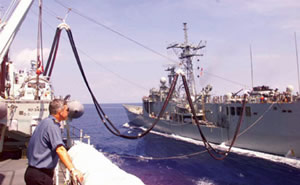The Post-War Years
The end of the Second World War saw the beginning of the Cold War — the struggle for dominance between Soviet-dominated communist countries and democratic countries (including the United States and Canada) in the post-war years. This tense showdown dominated world affairs for decades until the collapse of the Soviet Union in the early 1990s. Canada joined the North Atlantic Treaty Organization (NATO) in 1949 to form part of a western military alliance to help counter the Soviet threat. Since then, Canadian ships have trained and served on missions with NATO forces on a regular basis.
In addition to upholding our international treaty responsibilities during the Cold War, the Canadian Navy patrolled our own shores on the lookout for the Soviet submarines and long-range aircraft that were probing our defences. The stakes were high — when the Cuban missile crisis erupted in 1962 (after the United States discovered that the Soviet Union had stationed nuclear weapons just off the American coast in Cuba), RCN ships put to sea when the world seemed on the brink of nuclear war.
With the unification of the Canadian military in the late 1960s, the RCN changed its title and became known as Canadian Forces Maritime Command. The name may have changed but the navy has continued to contribute to our country’s reputation as a strong supporter of international peace support efforts and relief operations, as well. Indeed, Canadian aircraft carrier HMCS Magnificent transported troops and supplies for the first UN peacekeeping mission in Egypt in the wake of 1956's Suez Crisis. Ships of the Canadian Navy have also supported many other multinational operations and disaster relief efforts far from home over the years, such as those in Cyprus, the Persian Gulf, the former Yugoslavia, East Timor, the Hurricane Katrina-ravaged southern United States, and earthquake-battered Haiti.
Canada’s first military reaction in the wake of the terrorist attacks of September 11, 2001 came from the navy which quickly sailed to the waters off southwest Asia to contribute to the war on terror. They have continued this important work there over the years, patrolling and intercepting suspect shipping in the search for weapons and terrorists. Canadian warships also are active in the Indian Ocean as part of international efforts to stop piracy off the coast of Somalia.
Back at home, the Canadian Navy guards our coasts, watches for suspicious activity like smuggling and illegal foreign fishing, and assists in the aftermath of domestic disasters. The navy has also played an important role in asserting our country’s sovereignty in the Far North over the years and Canadian naval vessels regularly undertake exercises in the Arctic Ocean.
The past 100 years have often seen the Canadian Navy be the first to go into action when our country needs a military response. Today, the 33 Canadian warships, submarines, and coastal defence vessels operating off our coasts proudly carry on this tradition of service in the cause of peace and freedom.
Did You Know?
Today the Canadian Navy has no aircraft carriers, but that was not always the case. HMCS Bonaventure was Canada’s last aircraft carrier before being decommissioned in 1970.
The “Bonny,” as it was affectionately known, played various roles during its service, serving as a platform for anti-submarine aircraft, taking part in numerous NATO exercises and operations, and even transporting the Canadian soldiers and supplies needed to help establish the UN peacekeeping mission in Cyprus in 1964.
With a crew numbering up to 1,200, the ship formed a large — and giving — community afloat. In the 1960s, they held parties for disadvantaged children in ports in the Caribbean and Europe during international visits. The Canadians did their best to show the children an entertaining time, with miniature merry-go-rounds and pretend airplane and train rides, along with races, sailors dressed as clowns and pirates, and lots of hamburgers and ice cream being served.
Related Links
- Date modified:


